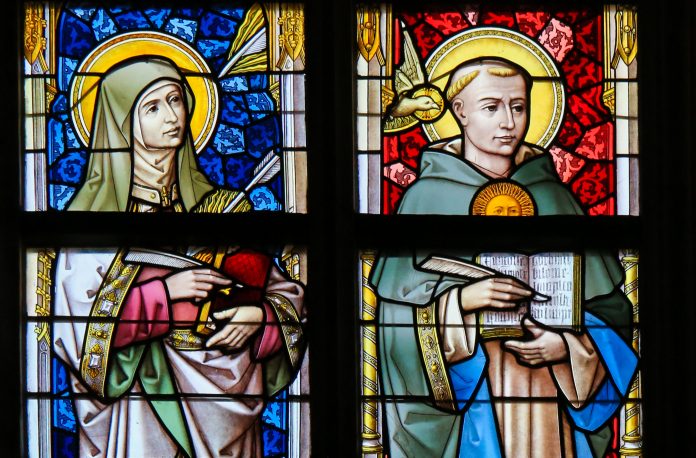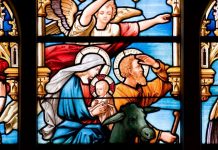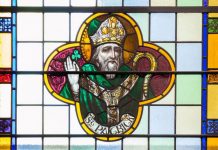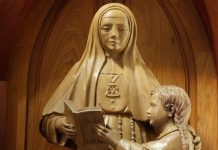
by Page McKean Zyromski
If you’d like a patron saint for when you’re slacking off,
look no further than the newly canonized Franciscan sister of Syracuse, New
York: St. Marianne Cope (1838–1918; canonized October 21, 2012; feast day,
January 23). She is famous for nursing lepers in Hawaii after St. Damien caught
the disease, but there’s much more. Sister Marianne’s stamina and dedication
were remarkable. And she was a catechist—one who believed that the gospel in
action speaks louder than words.
A Learning Sponge
Mother Marianne Cope started life in Germany as Barbara
Koob, immigrating to Utica, New York, when she was a year old. The family
changed the spelling of its name in its new country.
Young Barbara seems always to have been a “learning-sponge.”
If someone had something new to teach her, she soaked it up.
Soon after Barbara finished grade school, she learned
nursing skills as her father suffered a nine-year illness. She wanted to enter
the convent, but waited those nine years so she could work in a nearby factory
to bring home wages for the family.
Immediately upon entering the convent, Barbara’s (now Sister
Marianne) practical skills were put to use teaching school, nursing the sick in
their homes, and managing administrative duties for her order. As superior of
the new St. Joseph Hospital in Syracuse, Mother Marianne drew in medical
students who needed clinical practice. In the agreement with them, she stated
that patients’ rights would be paramount—a century ahead of her time.
To Be One of the Chosen
Then a visitor from Hawaii—seeking nurses for lepers—changed
her life. Mother Marianne longed to be “one of the chosen,” but she had duties
as the superior. She didn’t even pack a trunk when she accompanied the first six
sisters to Hawaii, because she expected to be back within a few weeks. Little
did she know that she would serve there for 35 years, until her death from
natural causes. She promised her sisters, “Wash your hands and you will not
catch leprosy.” To the present day, this remains true.
Once in Hawaii, the sisters set to work, first at the
leprosy hospital in Honolulu and then on the island of death itself, Molokai.
Besides bathing the sores and tending to nursing needs, the tireless women
scrubbed; painted; and planted trees, shrubs, and flowers. Mother Marianne
herself planted an orange grove where she was buried decades later.
Mother Marianne asked her friends to send bolts of colorful
cloth and ribbons. “Why do we need ribbons?” one patient asked. “We’re just
lepers. We’re going to die anyway.” Mother Marianne just smiled because she
knew that beauty and joy feed the soul no matter how much time a person has
left on earth. With her own hands, she sewed dresses for the women suffering
the disease, following the latest fashions. She also taught them how to do
needlework themselves, even with their diseased hands. Soon there was laughter
with sports, games, and music. Robert Louis Stevenson was an impressed visitor
who taught the lepers how to play croquet. He later sent a piano as a gift.
A Small Corner of Heaven
Things were not easy for Mother Marianne. There were
frequent funerals for ravaged bodies, and there was much criticism from
unexpected places. For example, Mother Marianne had to confront those who
abused her patients, even government officials.
Mother Marianne saw defending her patients as being part of
her job, her service to the “least of these.” About the many problems she
faced, she wrote in her journal: “No one knows but Jesus.”
To a nephew, she wrote: “I do not expect a high place in
heaven. I shall be thankful for a little corner where I may love God for all
eternity.”
May St. Marianne Cope give renewed inspiration to all of us
in our various ministries.
Page McKean Zyromski, a catechist for 45 years, has
been a contributor toCATECHIST since 1983. She lives in Painesville, OH.
You may contact her atpagezyromski.com.
Copyright 2013, Bayard, Inc. All rights reserved. This article is protected by United States copyright and other intellectual property laws and may not be reproduced, rewritten, distributed, redisseminated, transmitted, displayed, published or broadcast, directly or indirectly, in any medium without the prior written permission of Bayard, Inc.
This article was written by the Catechist Staff and appeared in Catechist magazine, December 2012.
Image Credit: Shutter Stock 544541167




